Open Planning of Sanitation Systems
Open Planning of Sanitation Systems
Open Planning of Sanitation Systems
You also want an ePaper? Increase the reach of your titles
YUMPU automatically turns print PDFs into web optimized ePapers that Google loves.
<strong>Open</strong> <strong>Planning</strong> <strong>of</strong> <strong>Sanitation</strong> <strong>Systems</strong><strong>Open</strong> <strong>Planning</strong> <strong>of</strong> <strong>Sanitation</strong> <strong>Systems</strong>Elisabeth Kvarnström and Ebba af PetersensSwedEnviro Consulting Groupi
EcoSanRes ProgrammeStockholm Environment InstituteLilla Nygatan 1Box 2142SE-103 14 Stockholm, SwedenTel: +46 8 412 1400Fax: +46 8 723 0348postmaster@sei.sewww.sei.seThis publication is downloadable fromwww.ecosanres.orgSEI CommunicationsCommunications Director: Arno RosemarinPublications Manager: Erik WillisLayout: Lisetta TripodiWeb Access: Howard CambridgeCopyright 2004 bythe EcoSanRes Programmeand the Stockholm Environment InstituteThis publication may be reproduced in whole or in part and in any form for educational or non-pr<strong>of</strong>itpurposes, without special permission from the copyright holder(s) provided acknowledgement <strong>of</strong>the source is made. No use <strong>of</strong> this publication may be made for resale or other commercial purpose,without the written permission <strong>of</strong> the copyright holder(s).ISBN 91 88714 95 0
ContentsPrefaceivBackground 1Objective 1Methodology 1The <strong>Open</strong> Comparative Consequence Analysis Method 1The Concept <strong>of</strong> Sustainability in Relation to <strong>Sanitation</strong> 2<strong>Open</strong> <strong>Planning</strong> <strong>of</strong> <strong>Sanitation</strong> <strong>Systems</strong> 2<strong>Open</strong> <strong>Planning</strong> <strong>of</strong> <strong>Sanitation</strong> <strong>Systems</strong> 3Step 1: Problem identification 3Stakeholder identification 4Step 2: Identification <strong>of</strong> boundary conditions 5<strong>Sanitation</strong> system boundaries 5Step 3: Terms <strong>of</strong> Requirement (ToR) 6Hygiene and disease protection 8Water protection 9Natural resources conservation 9Costs 10Reliability 10User aspects 10Responsibility and control 11Step 4: Analysis <strong>of</strong> possible solutions 11Step 5: Choice <strong>of</strong> the most appropriate solution 12Discussion 12References 13Appendices:Appendix 1: A Definition and Identification <strong>of</strong> Criteria for the Sustainability <strong>of</strong><strong>Sanitation</strong> <strong>Systems</strong> – 3rd Draft 15Appendix 2: Review <strong>of</strong> Some Existing <strong>Sanitation</strong> <strong>Planning</strong> and ImplementationHandbooks 19Appendix 3: Opinions on <strong>Planning</strong> in Existing Ecosan Projects – Survey Results 23Appendix 4: Matrix scoring exercise for Vadsbro village 26Appendix 5: Questionnaire regarding the use <strong>of</strong> planning and implementation toolsin ecosan projects 27iii
Elisabeth Kvarnström and Ebba af PetersensPrefaceThis desk study has been produced by Elisabeth Kvarnström and Ebba af Petersens inthe SwedEnviro Consulting Group, through funding from the Sida-financed EcoSanResprogramme.The list <strong>of</strong> criteria for sustainable sanitation in Appendix 1 was produced at a meeting heldin Stockholm on March 30 to April 1, 2004, where Patrick Bracken (GTZ), Alberto Ysunza(CECIPROC), Erik Kärrman (Urban Water), and Anders Finnson (Stockholm Water Co.)participated. Darren Saywell (WSSCC) contributed with written comments.The report has benefited from constructive comments from the EcoSanRes ProgrammeAdvisory Committee and also from Thomas Loetscher (Decisionscape, Australia).iv
<strong>Open</strong> <strong>Planning</strong> <strong>of</strong> <strong>Sanitation</strong> <strong>Systems</strong>BackgroundApproximately two fifths <strong>of</strong> the population in the world lack basic sanitation facilitiestoday. Basic sanitation is defined by WHO as being connected to a public sewer or septictank system, a pour-flush latrine, a simple pit latrine or ventilated improved pit latrine. Thislack <strong>of</strong> sanitation was highlighted during the World Summit on Sustainable Development inJohannesburg, 2002, where the Millennium Development Goal set to halve the proportion <strong>of</strong>the population without access to safe drinking water was amended to also include a reductionby half <strong>of</strong> the proportion <strong>of</strong> the world population without access to basic sanitation by 2015(UN, 2003). It is clear that a massive effort is needed to reduce this sanitation backlog in thecoming eleven years. Moreover, it is <strong>of</strong> utmost importance that the concept <strong>of</strong> sustainabilityis considered in regard to sanitation during investments and planning for sanitation upgrade:what is needed in order to supply a sanitation system that will be sustainable from a social, aswell as an economical and environmental perspective? In providing what may be considered astechnically well-functioning systems, we might risk ignoring the broader issues <strong>of</strong> sanitation,which include environmental protection and human health, the important social aspects <strong>of</strong>sanitation and broader economic aspects. An integrated view <strong>of</strong> sanitary planning where thesanitation planner is moving beyond figures <strong>of</strong> initial investment, operation and maintenancecost is required to supply sustainable sanitation.One way <strong>of</strong> reaching beyond the provision <strong>of</strong> purely technical solutions to sanitation is t<strong>of</strong>ocus on what criteria future sanitation systems should comply to in order to be sustainablein given settings. Such ‘criteria thinking’, or ‘functional requirements thinking’, can be usedboth on a macro level, by including criteria <strong>of</strong> sustainable sanitation in terms <strong>of</strong> referencefor sanitation projects financed on an international level, down to the micro level where thediscussions around sanitation investments in a municipality should be guided rather around thefunction requirements <strong>of</strong> the planned system than around sanitation techniques. By focusingon the function <strong>of</strong> a sanitation system rather than the technology itself, more room will beallowed for innovative solutions to sanitary problems (Tischner and Schmidt-Bleek, 1993).OBJECTIVEThe objective <strong>of</strong> this capacity-building project was to produce a tentative manual for theplanning and implementation <strong>of</strong> sanitation projects based on sanitation system functionrequirements rather than sanitation technologies, in order to supply sustainable sanitationsystems. The manual is intended to create and support an open and democratic sanitationplanning process and is aimed at planners and implementers at project level.METHODOLOGYThe <strong>Open</strong> Comparative Consequence Analysis MethodThe planning and implementation tool presented in this report is based on the <strong>Open</strong> ComparativeConsequence Analysis (OCCA) methodology that has been developed in Sweden by WRSUppsala AB (Ridderstolpe, 2000).Fundamental to OCCA planning is the recognition that the desired result, sustainablehousehold sanitation, can be achieved by utilization <strong>of</strong> different sanitation technologies.Ultimately, all factors influencing the sustainability <strong>of</strong> a sanitation system, such as local1
Elisabeth Kvarnström and Ebba af Petersensconditions, applicable regulations and user preference must guide the choice <strong>of</strong> a sanitationsolution. This will ensure that the system most appropriate and sustainable for a specificcommunity and its economic and environmental situation is selected. This approach alsoallows the promotion <strong>of</strong> new and innovative sanitation techniques, which is in accordance withthe BAT (Best Available Technique) principle that is a part <strong>of</strong> the environmental legislation inmany countries.The OCCA concept is based on the establishment <strong>of</strong> a set <strong>of</strong> criteria describing the functionrequirements or targets to be achieved by a sanitation system. These criteria are context-specificand are identified in cooperation with relevant stakeholders. They cover practical, economicand institutional aspects and are described in so-called Terms <strong>of</strong> Requirement (ToR). The ToRare then used to assess the merits <strong>of</strong> various sanitation alternatives. A final choice is then madefrom those alternatives fulfilling the needs outlined in the ToR.The Concept <strong>of</strong> Sustainability in Relation to <strong>Sanitation</strong>In this report we consider sanitation systems sustainable if they protect and promote humanhealth, do not contribute to environmental degradation or depletion <strong>of</strong> the resource base, aretechnically and institutionally appropriate, economically viable and socially acceptable 1 .A sanitation system encompasses, in our view, the users <strong>of</strong> the system, the collection,transport, treatment and management <strong>of</strong> the end products <strong>of</strong> human excreta, solid waste,industrial wastewater and storm water.A tentative list <strong>of</strong> criteria that might be <strong>of</strong> importance for sustainability in relation tosanitation is provided in Appendix 1.<strong>Open</strong> <strong>Planning</strong> <strong>of</strong> <strong>Sanitation</strong> <strong>Systems</strong>This methodology has been further developed into the <strong>Open</strong> <strong>Planning</strong> <strong>of</strong> <strong>Sanitation</strong> <strong>Systems</strong>concept by using results from:• a suggestion <strong>of</strong> criteria for sustainability in relation to sanitation, Appendix 1 2 ;• a survey about existing sanitation planning and implementation tools, presented inAppendix 2; and• views <strong>of</strong> selected sanitation pr<strong>of</strong>essionals as presented in Appendix 3.1 This definition <strong>of</strong> sustainability in relation to sanitation was agreed upon at a meeting held by EcoSanRes andGTZ, see Preface.2 The suggestion for criteria to consider for sustainability in relation to sanitation was identified during a meetingheld jointly by EcoSanRes and GTZ, see Preface for details.2
<strong>Open</strong> <strong>Planning</strong> <strong>of</strong> <strong>Sanitation</strong> <strong>Systems</strong><strong>Open</strong> <strong>Planning</strong> <strong>of</strong> <strong>Sanitation</strong> <strong>Systems</strong>Proper planning is the key to success in any type <strong>of</strong> project. The more fundamental andcontroversial the problems addressed by the project are, the more important it is that problemidentification and planning are made in a cross-cutting way, taking into consideration the voices<strong>of</strong> as many stakeholders as possible and as early on as possible. <strong>Sanitation</strong> planning definitelydemands a cross-cutting approach in order to provide sustainable sanitation systems.BOX 1: Stakeholder involvement in sanitation planningIn Sweden, piped water supply and sewerage were introduced to, among other things,improve public health and to protect the environment. The pr<strong>of</strong>essionals and the primary users<strong>of</strong> the system probably had an opportunity to express their views during the early planningand implementation stages. However, it is most probable that farmers, for various reasons,were either left out <strong>of</strong> or were not interested in the sanitation planning, development, andimplementation 3 . The Swedish sanitation system has now been in place for decades and isgenerating sewage sludge that the Farmer’s Association recommend their members not to use,due to the sludge not meeting the fertilizer quality demands <strong>of</strong> the food industry. This createsproblems for the society at large, and illustrates how a sanitation system can fail to function fullywhen stakeholders are not involved in its planning and selection. Similar observations can bemade in most parts <strong>of</strong> the world, both in developed and developing countries.<strong>Open</strong> planning <strong>of</strong> sanitation systems attempts to have a cross-cutting approach in its fivesteps described below. Some have similarities with the ‘STEPs’ suggested in the Household-Centred Environmental <strong>Sanitation</strong> approach as described in Schertenleib et al. (2004). We willuse a Swedish case study throughout these five steps for illustration purposes (Ridderstolpe,1999).CASE STUDY: Background informationVadsbro village is located in the county <strong>of</strong> Södermanland in Sweden. It comprises 40 householdsand a sewer system. The sewage system contains gravity-flow piping to a pumping station, fromwhich the sewage is pumped to the village’s run-down wastewater treatment plant. The plant issituated near a small, excavated river/ditch that drains both the village and the forest and farmsupstream. The treatment plant is surrounded by flat farmland and the owner <strong>of</strong> the land west<strong>of</strong> the treatment plant is willing to allow land to be used as part <strong>of</strong> the wastewater treatment(Ridderstolpe, 1999).STEP 1: PROBLEM IDENTIFICATIONProblem identification is an important component <strong>of</strong> successful project planning. If the problemand its causes are not identified, it is most probable that the project will fail down the line. Forproblem identification, we recommend the use <strong>of</strong> the logical framework approach (LFA) orPHAST. Both LFA and PHAST contain tools for problem identification and allow stakeholderparticipation. A workshop can be <strong>of</strong> great help further on in the process. In addition, the use3 It is probable that the abundance <strong>of</strong> chemical fertilizers after the Second World War made the farmers uninterestedin closing the loop issues and that the sanitation pr<strong>of</strong>essionals at the time did not see the need for nutrientrecycling either.3
Elisabeth Kvarnström and Ebba af Petersens<strong>of</strong> PHAST ensures that hygiene behaviour receives due attention. The workshop facilitatorshould, <strong>of</strong> course, be experienced in PHAST and LFA methodologies, and also be familiarwith the links between sanitation and agriculture and aquaculture, and above all, have a verygood understanding <strong>of</strong> the community situation.CASE STUDY: Problem identificationThe problem in Vadsbro was a poorly functioning wastewater treatment plant that neededupgrading in order to meet the wastewater discharge standards set by the local municipality. Theproject was initiated after some student reports from a nearby school had shown that alternativesto building a new treatment plant in the village existed.BOX 2: Participatory methods and sanitation planningThe survey <strong>of</strong> planning and implementation tools (Appendix 2) clearly indicated the needfor planning processes to facilitate the participation <strong>of</strong> future users <strong>of</strong> the systems and otherstakeholders to ensure project success. One-sided promotion <strong>of</strong> a single sanitation technologymay lead to a lack <strong>of</strong> project ownership and suspicion among future users that they are not<strong>of</strong>fered the best solution for their needs. Consequently, users will not be motivated to understandand use the proposed system correctly.The importance <strong>of</strong> participatory planning was also expressed by the survey respondents(Appendix 3). As one respondent expressed it: “to arrive in a community with the idea <strong>of</strong>implementing ecosan before consulting the community is making a mockery <strong>of</strong> participatoryapproaches and the project is probable to fail”. The respondents had a favourable opinion<strong>of</strong> PHAST, or, in a wider sense, the SARAR method, which several had used to facilitateparticipatory project planning. This approach would also be in accordance with the householdcentredenvironmental sanitation approach (HCES) as advocated by Schertenleib et al. (2004),where the household is the focal point <strong>of</strong> planning. According to Schertenleib et al. (2004) onlyproblems not manageable at the household level should be ‘exported’ to a larger jurisdiction, e.g.,neighbourhood, town or city.Stakeholder identificationThe stakeholder groups and their roles need to be identified. The stakeholders themselves or,for large communities, their representatives should be involved in the planning process earlyon. In sanitation planning, stakeholders may include:• Residents – users and <strong>of</strong>ten owners <strong>of</strong> the planned sanitation system• Planners and political decision makers – for example, municipal planning andenvironmental authorities• Schools and commercial operations• Land owners – owners <strong>of</strong> the land where components <strong>of</strong> the sanitation system will belocated• Contractors – they may be involved in the construction and/or operation and maintenance<strong>of</strong> the system• Farmers – users <strong>of</strong> treated waste products and, possibly, reclaimed water• Community-based organizations• Other stakeholders, such as neighbours with freshwater wells, people living downstream,etc.4
<strong>Open</strong> <strong>Planning</strong> <strong>of</strong> <strong>Sanitation</strong> <strong>Systems</strong>• Engineers, both public and private• Funding agenciesStakeholder involvement should build on e.g. PHAST/SARAR methodology, usingcommunity mapping <strong>of</strong> water and sanitation conditions. We recommend that agriculture andaquaculture and their relation to sanitation (e.g. flow <strong>of</strong> nutrients) are also included into thecommunity mapping.CASE STUDY: Stakeholder identificationResidents, the municipality, the landowner/farmer and the school were identified as stakeholdersand involved early on in the process. Although the project was very much a political processwithin the municipality, there was a great interest among the villagers. A village meeting was held,which a majority <strong>of</strong> the villagers attended. Several meetings at the municipality were held alongthe process, and the farmer/landowner was an interested and important participant.STEP 2: IDENTIFICATION OF BOUNDARY CONDITIONSThis step has similarities to ‘STEP 3: Assessment <strong>of</strong> current status’, in the HCES approach(Schertenleib et al., 2004). Having identified the problem, the next step is to investigatethe boundary conditions for the project. This could include a SWOT analysis (Strengths,Weaknesses, Opportunities and Threats) <strong>of</strong> the community situation. Additional questions thatwould have to be answered for identification <strong>of</strong> boundary conditions include:• Which socio-economic patterns prevail in the area?• Which cultural habits that could affect the choice <strong>of</strong> a sanitation system can beidentified?• Is there demand for improved sanitation in the population?• How well does the willingness to pay for improved services correspond to the capacity topay?• What is the legal framework?• Which waste flows exists within the area, and how do they relate to each other?• What does the area look like? What infrastructure is there? Location <strong>of</strong> nearby streamsand lakes?• What are the natural conditions such as groundwater level, soil conditions,precipitation?• What is the amount and quality <strong>of</strong> the wastewater fractions to be treated?• Are there successful sanitation schemes in neighbouring communities?The possibilities for financing construction, operation and maintenance are also analysed atthis initial stage. Are the households paying the actual costs, or a subsidized ‘connection fee’?Will the municipality pay for parts <strong>of</strong> the system? Is it possible to apply for grants?<strong>Sanitation</strong> system boundariesThe boundaries <strong>of</strong> the sanitation system need to be defined:• Where does the system begin and end?• Does the system include all wastewater fractions <strong>of</strong> the household? Will the wastewaterfractions be managed in a separate or combined manner?5
Elisabeth Kvarnström and Ebba af Petersens• Does the system start at the boundary <strong>of</strong> the garden or within the bathroom?• Does the system include other houses?• Does the system include treatment or only collection and discharge to a larger system?The system boundary definition is important for cost calculations, the definition <strong>of</strong>responsibilities, and for selecting a sampling point for, if applicable, outgoing wastewater.CASE STUDY: <strong>Sanitation</strong> system boundariesIn Vadsbro, there was an existing system with sewage pipes, pump stations and buildings.Therefore the system boundaries were set from the beginning, but extended to include anoutdoor treatment.STEP 3: TERMS OF REQUIREMENT (TOR)This step has similarities with ‘STEP 4: Assessment <strong>of</strong> user priorities’ in the HCES approach(Schertenleib et al., 2004). The terms <strong>of</strong> requirement (ToR) for assessing sanitation alternativesare usually set by the facilitator together with the stakeholders and in collaboration withlocal government to ensure compliance with regulations. This can be done by using PHAST/SARAR methodology. PHAST tools such as ‘blocking the routes’ can help identify ways toprevent disease propagation. If the project is <strong>of</strong> a larger scale, the ToR can be set in an LFAworkshop.ToR should be comprehensive and include all factors needed to ensure sustainable sanitationin the actual context. The discussion on what is needed for the sanitation to be sustainablecan be inspired by the list provided in Appendix 1. It is, however, extremely important toremember that this criteria list is a suggestion <strong>of</strong> what might be worthwhile to consider, andneeds to be adapted to the actual case.In open planning <strong>of</strong> sanitation systems we choose to organize the function requirementsin two blocks, where the first block contains what could be considered as primary functions,to avoid external effects, <strong>of</strong> a sustainable sanitation system. These primary functions includehygiene, environmental protection and resource conservation.The second block is more geared towards the user, where practical functions such as userfriendliness,reliability and affordability are discussed.These two blocks need to be considered in tandem and a balance between the two needsto be identified. The ToR, with these two blocks, can be compared to a bar for high-jumpers,where the level is set on one side by primary functions and on the other side by practicalconsiderations.Table 1 shows the ToR for Vadsbro village 4 , as developed by the concerned stakeholders(Ridderstolpe, 1999).Each heading in the ToR is explained and discussed below.4 Design # <strong>of</strong> pe: 140; design wastewater flow: 45 m 3 /day (pe = person equivalents)6
<strong>Open</strong> <strong>Planning</strong> <strong>of</strong> <strong>Sanitation</strong> <strong>Systems</strong>Table 1. ToR for Vadsbro village.Primary functionsHygiene and disease protection• Avoidance <strong>of</strong> sanitary nuisances, e.g. badodour• Infectious disease control, i.e. the effluentis either bathing water quality or excludedfrom direct exposure to humans until it hasachieved bathing water qualityRecipient protection• Phosphorous: reduced >90% (generalrequirement). In Vadsbro at most 0.1 kg/peas annual discharge and 50% (generalrequirement). In Vadsbro at most 2.5 kg/peas annual discharge. Discharged in the form<strong>of</strong> nitrate• BOD7: reduced >95 %Recycling <strong>of</strong> nutrients and/or organicmatter• Phosphorus: >75 % recycled• Other resources valuable for agriculturePractical considerations and cost aspectsCosts• Investment should not exceed USD 4000 perhousehold• Operation and maintenance should notexceed USD 250 per year per householdTechnical function• A proven, robust system that gives fewsurprisesAdaption to the local situation• Present and future land use in the area• Nutrient recycling possibilities in the area• Local objectives regarding energy andresource use• Possibilities to combine wastewatertreatment with open water and wildlifehabitat• Use <strong>of</strong> existing infrastructure when feasibleResponsibility and control• New systems may require new responsibilityarrangements between the municipality andfarmers• Discharge monitoring may be morechallenging for new systems and couldrequire new methods forTable 2 shows an example <strong>of</strong> ToR for assessing low-cost systems. It is important to rememberthat these are ToR examples only, and that a context-specific ToR must be identified for eachsetting together with the relevant stakeholders.7
Elisabeth Kvarnström and Ebba af PetersensTable 2. Example <strong>of</strong> ToR for a low-cost sanitation system.Primary functionsHygiene and disease protectionAll parts <strong>of</strong> the system and subsequenthandling <strong>of</strong> products must achieve a high level<strong>of</strong> hygiene and disease protection, including:• High hygienic standard within the toilet,the washing area, and with regards togreywater/wastewater effluent, etc.• Excreta must be stored/disposed <strong>of</strong>without risk <strong>of</strong> seepage <strong>of</strong> pathogens to thegroundwater• It must be possible to manage collection anddisposal <strong>of</strong> waste products in a hygienicallysafe mannerWater Protection• Excreta must not be stored or disposed <strong>of</strong>so that there is a risk <strong>of</strong> leachate <strong>of</strong> nutrientsinto the groundwater• Surface waters (ditches, ponds, rivers,lakes) should be protected from nutrientsand organic matter originating from toiletsand greywater/wastewaterNatural resources conservation• Virtually all nutrients from the sanitarysystem (urine as well as faeces) shouldbe recycled to productive land, so as tominimise nitrogen losses within the system,pollution, etc.• The system (washing area etc.) should beconstructed in a way that allows collectionand recycling <strong>of</strong> waterPractical and economical aspectsEconomics• Investment costs should be reasonable• Households should be able to carry outoperation and maintenance in kindReliability• The technology must be robust, also duringextreme weather conditionsFlexibility• It should be possible to adapt the technologyto varying household sizes. The systemshould work without electricityUser aspects• The toilet should be inside the house• The system must be easy to use, includingfor children, women, and the elderly• Maintenance should be quick and easyResponsibility• Responsibilities <strong>of</strong> households andauthorities must be clearControl• It must be possible to evaluate the systemperformanceHygiene and disease protectionThe sanitation system, including black- and greywater and solid waste, should not causeunsanitary conditions or nuisances such as odours or insect infestation in any part <strong>of</strong> thesystem.The toilet should be easy to use and preferably be made <strong>of</strong> materials with a smooth surfaceto facilitate cleaning. Excreta must not be stored or disposed <strong>of</strong> in a manner resulting ingroundwater contamination by pathogens. Therefore, an elevated collection tank is preferablefor dry systems (SMI, 2004).Handling <strong>of</strong> waste products, i.e. treated greywater, urine, faeces, sludge etc. should bepossible to accomplish in a hygienic way, using appropriate procedures and equipment, suchas wearing gloves and good hand-washing practices (SMI, 2004).Recycling <strong>of</strong> waste products must be hygienically safe. This means that fresh faecesespecially, which may contain large numbers <strong>of</strong> pathogens, must be treated before recycling.Suitable methods <strong>of</strong> treatment are long-term storage, composting and the addition <strong>of</strong> ash andlime. On a municipal scale, secondary treatment for faeces in larger systems may includealkaline treatments, composting and incineration (SMI, 2004). For urine, storage for a certain8
<strong>Open</strong> <strong>Planning</strong> <strong>of</strong> <strong>Sanitation</strong> <strong>Systems</strong>period will result in a hygienically safe fertiliser. When recycling nutrients in wastewater,measures must also be taken to minimize risks to public health. For example, wastewater thatwill be used for irrigation in California on produce to be eaten raw, needs secondary treatment,to be coagulated, filtered and disinfected (Metcalf & Eddy, Inc., 1991).Water to be discharged, whether greywater or mixed wastewater from a conventional system,should not pose risks to humans or the environment. The outgoing water should be treated anddischarged to surface waters or be reclaimed for irrigation. Infiltration as a means to treatwastewater/greywater should generally be avoided, as undisturbed groundwater is normallysuitable for human consumption and thus should be protected from pollution, unless the localconditions allow for such a treatment alternative.Water protectionSurface water (ditches, ponds, rivers, lakes) and groundwater should, as far as possible, beprotected from nutrients, organic matter and pathogens originating from toilets and greywater/wastewater. What “as far as possible” means needs to be identified for each setting. In a denselypopulated area with a heavily polluted river, “as far as possible” may mean that removal <strong>of</strong>virtually all pollutants is required.BOX 3: Water protection in SwedenIn Sweden, there is sometimes a demand on wastewater treatment units to provide a 90 percent reduction <strong>of</strong> phosphorus and organic matter, depending on the sensitivity <strong>of</strong> the effluentrecipient. Moreover, detergents with low phosphorus content are recommended for householdsnot connected to a wastewater treatment plant.This would mean that excreta are managed in a way that does not result in nutrientsleaching into the groundwater. As mentioned above, since groundwater may be used forhuman consumption and thus should be protected from pollution, infiltration as a means totreat wastewater or greywater should generally be avoided, unless the local conditions allowfor such a treatment alternative. Greywater should be treated before discharge.Natural resources conservationNatural resources to be considered for sanitation systems include water, nutrients, landrequirement and energy.BOX 4: Nutrient recycling in SwedenNutrient recycling is promoted in Sweden in accordance with the national environmental qualityobjectives, provided that the nutrients are not associated with harmful substances such as e.g.heavy metals.It is possible to recycle virtually all nutrients from human excreta to agriculture or otherproductive areas. Before recycling, the urine, faeces, sludge, wastewater for irrigation etc.must be sanitized, see Hygiene and disease protection above.9
Elisabeth Kvarnström and Ebba af PetersensIn areas where freshwater is scarce, the system may include reclamation <strong>of</strong> wastewater orgreywater. The reclaimed water can be used for domestic purposes, including yard irrigation,but should not be used as drinking water. However, the risk <strong>of</strong> soil salinization needs to beaddressed in climates with high evapotranspiration and low rainfall.CostsThe sanitary solution chosen should be economically reasonable with regards to capital as wellas recurrent costs. What “reasonable” entails varies much between countries and locales anddepends on the purchasing power <strong>of</strong> a community.A possible approach is to assume that the cost <strong>of</strong> a new system should not be significantlyhigher than the cost <strong>of</strong> systems generally used in a community. If subsidies or grants areavailable, then the actual investment cost may be <strong>of</strong> less importance.The user is normally responsible for operating the system and, therefore, also bears the cost<strong>of</strong> operation and sometimes also the maintenance. This cost could be in the form <strong>of</strong> in-kindwork only, i.e. no expenses are incurred, or it could include payment <strong>of</strong> contractors.ReliabilityInadequate system reliability will cause negative effects on users in terms <strong>of</strong> hygienic andenvironmental performance <strong>of</strong> the system and costs. The system should allow management<strong>of</strong> operational problems without negatively affecting people, property or the environment. Itis, however, best to avoid operational problems by selecting technologies that are robust andthat can cope with extreme weather conditions. Therefore, a basic function requirement is thatthe system is technically reliable. Additionally, the expertise to run and maintain equipmentshould be available locally.User aspectsThe sanitary installations (e.g. toilet, greywater) on the premises should fulfil basic userrequirements concerning affordability, user friendliness, maintenance, reliability, comfort,privacy, and status. It is also important to ensure realistic expectations <strong>of</strong> the system throughcapacity building and information. Irrespective <strong>of</strong> the technical solution chosen, it is essentialthat households use the system in an appropriate way. Water consumption and the typeand quantity <strong>of</strong> detergents are examples <strong>of</strong> factors that have a significant impact on systemperformance.Another aspect to consider is the experience <strong>of</strong> users with certain (including the current)institutional frameworks and their relationship with authorities. For example, different societiesand groups in a society will have different experiences with financial instruments, such astariffs or taxes. This in its turn will have an impact on which incentives will be effective. If theregulation enforcement is poor, which is <strong>of</strong>ten the case in many countries, it is important thatthe motivation to “do things the right way” comes from within the community.Further, the system should accommodate existing household habits and routines, ratherthan making the daily tasks more demanding or time-consuming. In fact, one <strong>of</strong> the greatestdriving forces for a new system seems to be the reduction <strong>of</strong> the time taken to complete dailytasks, and the resulting economic benefits (Drangert, 2004). It must be borne in mind, however,that when it comes to sanitation, gender aspects can play an important role concerning theallocation <strong>of</strong> daily tasks.10
<strong>Open</strong> <strong>Planning</strong> <strong>of</strong> <strong>Sanitation</strong> <strong>Systems</strong>Another aspect to consider is that the views people have about excreta and its handling canvary greatly. People might get disgusted when seeing excreta in, for example, a toilet, but onthe other hand have no objections to using excreta for medical practices when sick (Drangert,2004).It is also important for the various stakeholder groups to understand how the system works.For the residents, for example, this could mean that they understand how their sanitation systemworks and how to operate and maintain it. For planners, on the other hand, this may includeunderstanding contamination loops and the natural water cycle. This knowledge, or the lack <strong>of</strong>it, will directly affect the choice <strong>of</strong> a sanitation system and expectations <strong>of</strong> it.Further, installations should suit women and men, disabled, elderly people and children. Forexample, if urine-diversion is used, additional urinals could be considered for men to avoidmisuse <strong>of</strong> the system.Responsibility and controlResponsibilities for operation and maintenance <strong>of</strong> a sanitation system can be organized in manyways. For example, each household could own and manage its system. Or each householdowns its system, but operates it together with other households. A third alternative is that amunicipality or a joint organization owns and operates all system components.For a single family, it is usually best to select a standard sanitary solution. For a wholevillage, it is possible, and may be more cost-effective and practical, to design a tailor-madesystem. A centralized or semi-centralized system, with, for example, central storage <strong>of</strong> urine,facilitates design, construction, and maintenance for the system at large. Irrespective <strong>of</strong>the organizational form, it is important to have a clear delineation <strong>of</strong> private and collectiveresponsibilities, and to have a person in charge who is accountable for system performance inaccordance with the ToR.Control <strong>of</strong> small sanitary systems cannot, due to practical and economical reasons, be carriedout in the same way as for large treatment plants. Therefore, carefully performed <strong>of</strong>f-sitetesting can be used to estimate on-site performance. For source diversion, nutrient amountsand contents can be measured in samples <strong>of</strong> urine and faeces from the collection tanks. Tomonitor treatment performance, the effluent can be sampled.STEP 4: ANALYSIS OF POSSIBLE SOLUTIONSThis step has similarities with ‘STEP 5: Identification <strong>of</strong> options’ in the HCES approach(Schertenleib et al., 2004). In Step 4, different sanitation solutions complying to the ToR, asdefined in Step 2, are compared. At this point the facilitator might need to consult sanitationspecialists for the identification <strong>of</strong> appropriate sanitation alternatives and concerning theircompliance with the ToR. It is important to analyse the solutions not only with regards totheir economic performance, but also with respect to all other criteria in the ToR, especiallyhygiene performance. Moreover, the solutions must be feasible and appropriate for the contextin question.At least three appropriate (i.e. solutions that fulfil the ToR) sanitation systems shouldbe presented to the community to choose from. It should be clearly explained why sometechnologies do not fulfil the ToR, for example with a matrix scoring exercise. The matrixscoring exercise for Vadsbro village is shown in Appendix 4. The proposed solutions are11
Elisabeth Kvarnström and Ebba af Petersensstudied and discussed in such detail that that the community understands why they are feasibleand adequate. The alternatives that do not fulfil the ToR are abandoned.CASE STUDY: Possible sanitation system solutions identified for Vadsbro village1. Primary treatment, storage and forest irrigation2. Stabilization ponds with chemical (Ca(OH) 2precipitation3. Primary treatment, trickling filter and bi<strong>of</strong>ilter ditch4. Primary treatment, trickling filter and crop/wetland rotation5. Primary treatment, sand filter and bi<strong>of</strong>ilter ditch/wetland6. Package treatment plant (sequencing batch reactor, SBR), including nitrification followed by abi<strong>of</strong>ilter ditch or wetland.Four different wastewater systems with decentralized solutions were also proposed to thestakeholders but were not accepted. The reason for this was the fact that the centralized systemalready existed where the sewerage system had been subject to a recent renovation.The matrix scoring exercise is available in Appendix 4.STEP 5: CHOICE OF THE MOST APPROPRIATE SOLUTIONStep 5 has similarities with the HCES approach STEPs 6-8 (Schertenleib et al., 2004). The<strong>Open</strong> <strong>Planning</strong> <strong>of</strong> <strong>Sanitation</strong> <strong>Systems</strong> Step 4 resulted in at least three sanitation alternativesthat comply to the ToR. The final step is to evaluate and compare these alternatives, using, forexample, a PHAST tool called ‘<strong>Sanitation</strong> Options’ and the matrix scoring exercise mentionedabove. The final choice should be made by the future users <strong>of</strong> the proposed sanitation system.CASE STUDY: Final choice <strong>of</strong> sanitation system for Vadsbro villageThe stakeholders finally settled for alternative 3 above, after having discussed the consequences<strong>of</strong> each alternative in relation to the ToR with the sanitation expert. Presentations with simplesketches were used showing how each alternative worked technically and also its complianceand consequences according to the ToR. The use <strong>of</strong> ToR made the comparison between thealternatives quite easy. Considerations <strong>of</strong> costs and risks were decisive for the stakeholders’decision. Alternative 6, the package treatment plant, was the initially favoured alternative.However, the bi<strong>of</strong>ilter ditch in alternative 3 was seen, after going through the alternatives inrelation to the ToR, as both significantly less expensive and more efficient for pollutant reductionand nutrient recycling (Ridderstolpe, 1999).DiscussionBy looking at several sanitation alternatives, the future users have the opportunity to select, ina participatory process, the system that best matches their preferences and that is affordable.Municipalities, private companies and NGOs will be less likely to show monopolistic behaviourand to impose their solutions on the future users. Merits, risks and costs <strong>of</strong> a sanitation systemwill be presented in an open process, and an informed choice can be made by future users andother stakeholder groups. As a result, they will be confident that they have selected the solutionmost appropriate for their situation and specific needs. This in turn will increase the likelihood<strong>of</strong> proper system operation and maintenance.12
<strong>Open</strong> <strong>Planning</strong> <strong>of</strong> <strong>Sanitation</strong> <strong>Systems</strong>Even though the proposed procedure will take more time and cost more, it is likely to savetime in the implementation phase, and to reduce overall project cost by allowing stakeholdersto select a system that is sustainable both economically, socially and environmentally.The <strong>Open</strong> <strong>Planning</strong> <strong>of</strong> <strong>Sanitation</strong> <strong>Systems</strong> method is a tentative planning tool, which needsto be tested in real planning situations. Moreover, it would be useful to harmonize the steps in<strong>Open</strong> <strong>Planning</strong> <strong>of</strong> <strong>Sanitation</strong> <strong>Systems</strong> with the HCES STEPs (Schertenleib et al., 2004).ReferencesDrangert, J-O. 2004. Norms and Attitudes Towards Ecosan and Other <strong>Sanitation</strong> <strong>Systems</strong>, EcoSanRes Report no.5 (manuscript)Metcalf & Eddy, Inc. 1991. Wastewater Engineering – Treatment, Disposal, Reuse. McGraw-Hill InternationalEditions, 3 rd ed.Ridderstolpe, P. 1999. Wastewater treatment in a small village – options for upgrading. SwedEnviro report No1999:1.Ridderstolpe, P. 2000. Comparing Consequence Analysis – a Practical Method to Find the Right Solution forWastewater Treatment. http://www.iees.ch/EcoEng001/EcoEng001_R4.htmlSchertenleib, R., Morel, A., Kalbermatten, J., Saywell. D. 2004. Guidelines for the implementation <strong>of</strong> the Bellagio-Principles and the household centred environmental sanitation approach (HCES). Ecosan – closing the loop.Proceedings <strong>of</strong> the 2 nd international symposium on ecological sanitation, April 7–11, 2003, held in Lübeck,Germany.Tischner, U., Scmidt-Bleek, F. 1993. Designing Goods with MIPS. Fresenius Envir. Bull., 2, pp.479-484.SMI, 2004. Guidelines on the Safe Use <strong>of</strong> Urine and Faeces in Ecological <strong>Sanitation</strong> <strong>Systems</strong>. EcoSanRes Reportno. 1 (manuscript).UN. 2003. Water for People Water for Life. The United Nations World Water Development Report.13
<strong>Open</strong> <strong>Planning</strong> <strong>of</strong> <strong>Sanitation</strong> <strong>Systems</strong>Appendix 1: A Definition and Identification <strong>of</strong> Criteria for theSustainability <strong>of</strong> <strong>Sanitation</strong> <strong>Systems</strong> – 3rd DraftTo be published within the EcoSanRes 1 programmePatrick Bracken (GTZ), Anders Finnson (Stockholm Water Company), Elisabeth Kvarnström *(EcoSanRes), Erik Kärrman (Urban Water), Darren Saywell (WSSCC) and Alberto Ysunza(CECIPROC).* Contact person, address: VERNA Ecology, Inc; Malmgårdsvägen 14, 116 38 Stockholm, Sweden, e-mail: elisabeth@verna.se, phone #: +46-70-6178855BACKGROUNDThis working paper is the result <strong>of</strong> a three-day meeting held in Stockholm where sustainability inrelation to sanitation was discussed and an extensive list <strong>of</strong> criteria to meet sustainability in sanitationwas proposed. The organizations present at the meeting were• EcoSanRes, a Sida-funded environmental and development programme on ecological sanitation• Deutsche Gesellschaft für Technische Zusammenarbeit, GTZ• Centro de Capacitación Integral para Promotores Communitarios, CECIPROC in Mexico• Urban Water, a Swedish research programme on Sustainable Urban Water Management• Stockholm Water CompanyWater Supply and <strong>Sanitation</strong> Collaborative Council participated through written comments.SYSTEM BOUNDARY DEFINITIONAn additional, important consideration during the meeting was to identify what would be the appropriateboundaries <strong>of</strong> a sanitation system. This is <strong>of</strong> utmost importance when comparing different systems for aparticular context, and should be determined in such a way as to ensure that there is no export in eitherspace or time <strong>of</strong> problems that may be created by the system. It is reasonable to include at least the user<strong>of</strong> the system, the management <strong>of</strong> wastewater and its residual fractions, within the system boundaries.It is also possible, and even desirable, to include generation <strong>of</strong> nutrients and recovery <strong>of</strong> energy withinthe system boundaries.SUGGESTION OF CRITERIA TO CONSIDER FOR SANITATION SYSTEMS TO BESUSTAINABLEIt is impossible to identify a complete list <strong>of</strong> factors that will affect the sustainability <strong>of</strong> a sanitationsystem without knowing the specific context. Moreover, a list <strong>of</strong> criteria will not provide easy answers inthe decision-making process but it will help narrow down the discussion. The attempt here is therefore totry and present an extensive range <strong>of</strong> different criteria that might be <strong>of</strong> importance in different contexts.The list would need to be reduced/expanded for each specific case. There will also be a need to identifylocally relevant criteria that do not appear on this suggested list, irrespective <strong>of</strong> level <strong>of</strong> intervention,in close cooperation with all relevant stakeholders, the current legal framework and current cultural1 EcoSanRes (ecological sanitation research) is an international environment and development programme on ecologicalsanitation. It has its roots in the pioneering SanRes programme which ran from 1993 to 2002. It is sponsored by Sida,managed by Stockholm Environment Institute with Akkadia Environment, SwedEnviro and Vatema, and brings together aworld network <strong>of</strong> 20 organisations. For more information on the EcoSanRes programme, please consult www.ecosanres.org15
Elisabeth Kvarnström and Ebba af Petersenspractices. The content <strong>of</strong> the list may depend on the level at which the criteria are used (household,neighbourhood, community, municipality, government, international donors etc.). Moreover, the listproposed here does not take into account the fact that certain criteria might need to be considered atdifferent stages in the planning process and that there might be a need to weigh criteria against eachother. For the specific planning case there is also a need to connect this criteria list to a sanitationplanning tool adapted for the level <strong>of</strong> intervention. A list <strong>of</strong> criteria could also serve as a checklist toidentify knowledge gaps for different sanitation systems, with respect to their sustainability in a givensetting.Below we present what we think might be important criteria, with which one could assess differentsanitation systems before deciding what approach/system/technique would be the most suitable in agiven setting. This list <strong>of</strong> criteria is based on the work <strong>of</strong> several different authors who have workedin this area (e.g. Balkema, 2003; Hellström et al., 2000; Urban Water, 2004; Larsen & Gujer, 1997;Larsen & Lienert, 2003; Lennartsson, 2004) as well as on the discussions held during the meeting. Theyhave been divided into five broad categories <strong>of</strong> criteria which we believe cover the main areas to beaddressed by a sanitation system. The list will hopefully encourage discussion and we would welcomeall feedback related to it.CriteriaIndicatorHealthRisk <strong>of</strong> infection <strong>of</strong> complete use <strong>of</strong> systemRisk <strong>of</strong> exposure to harmful substances: heavy metals, medical residues,organic compoundsRisk assessment or qualitativeRisk assessment or qualitativeEnvironment• Use <strong>of</strong> natural resources, construction:• Land (investment)• Energy• Construction materials• Chemicalsm 2 /peMJ/peType and volumeType and volumeUse <strong>of</strong> natural resources, O&M:• Land (investment)• Energy• Fresh water• Construction materials• Precipitation agents or other chemicalsm 2 /pe/yrMJ/pe/yrm 3 /pe/yrType and volume/pe/yrType and volume/pe/yrDischarge to water bodies:• BOD/COD• Impact on eutrophication• Hazardous substances: heavy metals, persistent organic compounds,antibiotics/medical residues, hormonesg/pe/yrg/pe/yr <strong>of</strong> NPmg/pe/yrAir emissions:• Contribution to global warming• Odourkg <strong>of</strong> CO 2equivalent/yrQualitativeResources recovered (potential for approaches):• Nutrients% <strong>of</strong> incoming to system <strong>of</strong> NPKS16
<strong>Open</strong> <strong>Planning</strong> <strong>of</strong> <strong>Sanitation</strong> <strong>Systems</strong>• Energy• Organic material• Water% <strong>of</strong> the consumption <strong>of</strong> thesystem% <strong>of</strong> incoming to the system% <strong>of</strong> incoming to the systemQuality <strong>of</strong> recycled products (released to soil):• Hazardous substances: heavy metals, persistent organic compounds,antibiotics/medical residues, hormonesmg/unitEconomyAnnual costs, including capital and maintenance costsCapacity to pay – user (% <strong>of</strong> available income), municipalityLocal developmentCost/pe/yrDisposable income/peQualitativeSocio-culture (institutional and user related)Willingness to pay (% <strong>of</strong> available income)Convenience (comfort, personal security, smell, noise, attractiveness,adapted to needs <strong>of</strong> different age, gender and income groups)Reasonable % <strong>of</strong> incomeQualitativeInstitutional requirementsResponsibility distributionCurrent legal acceptabilityAppropriateness to current local cultural context (acceptable to use andmaintain)System perception (complexity, compatibility, observability – includingaspects <strong>of</strong> reuse)Ability to address awareness and information needsDefinition <strong>of</strong> level <strong>of</strong> organizationQualitativeQualitativeQualitativeQualitativeTechnical functionSystem robustness: risk <strong>of</strong> failure, effect <strong>of</strong> failure, structural stabilityRobustness <strong>of</strong> use <strong>of</strong> system: shock loads, effects <strong>of</strong> abuse <strong>of</strong> systemRobustness against extreme conditions (e.g. drought, flooding,earthquake etc.)Possibility to use local competence for constructionPossibility to use local competence for O&MEase <strong>of</strong> system monitoringDurability/lifetimeComplexity <strong>of</strong> construction and O&MCompatibility with existing systemFlexibility/adaptability (to user needs and existing environmentalconditions – high groundwater level, geology etc.)QualitativeQualitativeQualitativeQualitativeQualitativeQualitativeYrsQualitativeQualitativeQualitativeAll categories are considered over the entire life cycle <strong>of</strong> the sanitary system – from resource extractionfor its construction to it eventually being taken out <strong>of</strong> service at the end <strong>of</strong> its useful life.Additionally – there are strong overlaps between the categories, with, for example, items mentionedin economy possibly also fitting under socio-cultural.17
Elisabeth Kvarnström and Ebba af PetersensHealthThe prime objective <strong>of</strong> sanitation is to protect and promote human health. The entire sanitary systemshould therefore be hygienically safe, posing as small a risk as possible <strong>of</strong> infection. This covers the use<strong>of</strong> the sanitary installation, collection, transport, treatment and end destination <strong>of</strong> the treated products.The risk <strong>of</strong> infection from leaking sewers to the drinking water pipe system or groundwater should alsobe included, as there is also risk <strong>of</strong> being infected when bathing in lakes or the sea nearby an overflowor discharge point from a treatment plant.EnvironmentWith time, sanitary systems have also been developed in such a way so as to protect the environmentagainst possible detrimental effects. There is a need to consider emissions to different recipients (water,soil and air), and also resource use by different sanitation systems, both during the construction and theoperation phase. Moreover, it is important to consider the quality <strong>of</strong> the treatment product for possiblereuse in agriculture.EconomyThe capacity to pay for sanitation among the users is an important criteria for sustainability. However,in the end it may be their willingness to pay that will define within what range the costs, both <strong>of</strong>construction and O&M, can vary and services be sustained financially by the population.Socio-cultureThe prime objectives <strong>of</strong> sanitation might be to protect human health and the environment. However,sustainability in sanitation cannot be based only on these objectives but need to include social criteriaas well as they are most crucial to sustainability in use and services provided by the system. It ispossible to distinguish at least three different types <strong>of</strong> important criteria in this category, namely culturalacceptance, institutional requirements, and perceptions on sanitation. The society is more dynamic thanhuman health and the environment and therefore the socio-cultural criteria, like regulation, perceptionson systems etc. might be subject to a more dynamic change through time than criteria consideringhuman health and the environment. How things are seen and their resultant acceptance can change withtime (perhaps driven by their own priorities).Although improved human health and environment are the main objectives to planners and politicians,this might not be enough to sell the sanitation concept to future users. It is also important to recognizethat the prime driver for sanitation might be security and status rather than health and environment(Holden, 2003). Another sanitation driver could be the possibility <strong>of</strong> increased food security if thesanitation solution can provide hygienically safe fertilizers.Technical functionThe technical functions <strong>of</strong> the sanitation system are definitely important for it to be sustainable. One <strong>of</strong>the more important ones is probably robustness, both within the system (to be able to receive varyingloads) and externally (to be able to withstand varying extreme environmental conditions as well as userabuse <strong>of</strong> the system).The technical functioning <strong>of</strong> the system is seen as perhaps the most flexible group <strong>of</strong> criteria.Technologies can, to a large extent, be relatively easily adapted to the needs and requirements – it iseasier to adapt the technology to the wider needs than vice versa.18
<strong>Open</strong> <strong>Planning</strong> <strong>of</strong> <strong>Sanitation</strong> <strong>Systems</strong>REFERENCESvan der Vleuten-Balkema, A. 2003. Sustainable Wastewater <strong>Systems</strong> – Developing a Methodology and SelectingPromising <strong>Systems</strong>. Dissertation, Technische Universiteit, Eindhoven, the Netherlands.Hellström, D., Jeppsson, U., & Kärrman, E. 2000. <strong>Systems</strong> Analysis <strong>of</strong> Urban Water Management. EnvironmentalImpact Assessment Review, 20 (3).Holden, R. 2003. Factors which have influenced the acceptance <strong>of</strong> ecosan in South Africa and development <strong>of</strong> amarketing strategy. Ecosan – closing the loop. Proceedings <strong>of</strong> the 2 nd international symposium on ecologicalsanitation, April 7 – 11, 2003, held in Lübeck, Germany.Larsen, T. & Lienert, J. 2003. Societal Implications <strong>of</strong> Re-Engineering the Toilet. Water Intelligence Online, March2003.Larsen & Gujer 1997. The concept <strong>of</strong> sustainable urban water management. Wat. Sci. Tech 35(9), p 3-10.Lennartsson, M. 2004. Review <strong>of</strong> Alternative <strong>Sanitation</strong> <strong>Systems</strong>. EcoSanRes working paper, draft version.Tischner, U. & Schmidt-Bleek, F. 1993. Designing goods with MIPS. Fresenius Envir. Bull., vol 2, pp 479-484.Urban Water, 2004. MIKA – Methodologies for Integration <strong>of</strong> Knowledge Areas. Surahammar Case Study (draftin Swedish).WSSCC, 2000. Report <strong>of</strong> Environmental <strong>Sanitation</strong> Working Group for 5 th Global Forum. Water Supply and<strong>Sanitation</strong> Collaborative Council (WSSCC), Geneva, Switzerland.Appendix 2: Review <strong>of</strong> Some Existing <strong>Sanitation</strong> <strong>Planning</strong> andImplementation Tools from an Ecological <strong>Sanitation</strong> PerspectiveEcological sanitation entails the hygienically safe reuse <strong>of</strong> human excreta in agriculture. The pillars<strong>of</strong> ecological sanitation are containment, sanitization and nutrient reuse 2 . Thus, ecological sanitationprojects entail involvement with at least one more field than conventional sanitation projects, it beingagriculture. There is therefore a need to review existing sanitation planning and implementation tools,in order to assess their capacity to fully include all aspects <strong>of</strong> ecological sanitation. Our attempt in thissection <strong>of</strong> the report is to review some existing sanitation planning and implementation tools from anecological sanitation perspective. For a more extensive survey we recommend the ecosan source bookfor the preparation and implementation <strong>of</strong> ecosan projects, currently being compiled by the ecosan teamat GTZ (www.gtz.de). Worth mentioning here is the SANEX s<strong>of</strong>tware, developed at the University <strong>of</strong>Queensland, Australia and co-financed by the Swiss Development Cooperation (Loetcher & Keller,2002). However, this tool is not further analysed in this report.PHAST/SARAR (WOOD ET AL., 1998)Background/aim <strong>of</strong> toolThe PHAST/SARAR guide was developed to help community workers promote community hygienebehaviour change and to improve water and sanitation facilities. This is achieved by demonstration<strong>of</strong> the relationship between sanitation and health status, by increasing self-esteem <strong>of</strong> the communitymembers, and by empowerment <strong>of</strong> the community to plan environmental improvements and to own andoperate water and sanitation facilities.The guide presents seven steps, <strong>of</strong> which the first five take the community through the development<strong>of</strong> a plan to prevent diarrhoeal diseases by improving its water supply, hygiene behaviour and sanitation.Steps six and seven are about monitoring and evaluation.2http://www.ecosanres.org19
Elisabeth Kvarnström and Ebba af PetersensEvaluation <strong>of</strong> PHAST/SARAR from an ecological sanitation perspectiveThe key strength <strong>of</strong> PHAST/SARAR is that it is a tool to be used by the community. However, nospecial focus is made on the recycling <strong>of</strong> nutrients. The tool could be further developed to take nutrientrecycling into consideration, using other sets <strong>of</strong> questions and pictures etc. In the province <strong>of</strong> Niassa inMozambique, communities were taken through a PHAST process that helped them decide what key waterand sanitation problems they would like to address. In these cases, several communities choose differentecological sanitation options over improved latrines (Breslin, 2003). Social marketing techniques suchas using local radio, demonstration latrines during festivals, and agricultural demonstration plots wereused in combination with the PHAST process in Niassa (Breslin, 2003).LOGICAL FRAMEWORK APPROACH (SIDA, 2002)Background/aim <strong>of</strong> toolLFA is a method for objective-oriented planning, logical analysis, appraisal and evaluation <strong>of</strong> projects<strong>of</strong> any kind. The full use <strong>of</strong> the LFA method will facilitate improved dialogue between different projectstakeholders and increase responsibility and ownership <strong>of</strong> the project. It also contributes to the illustrationand concretization <strong>of</strong> the objectives, and <strong>of</strong> activities needed to achieve these objectives. The use <strong>of</strong> LFAmatrixes is a format for describing projects, and facilitates the follow-up and evaluation <strong>of</strong> projects.The LFA contains nine different steps:1. Context2. Problem analysis3. Stakeholder analysis4. Objectives analysis5. Activities6. Resources7. Indicators8. Risks9. AssumptionsIf effects <strong>of</strong> external risks (politics, natural disasters, corruption etc.) can be kept under control and thedeveloped project plan is followed, the project will be likely to be successful.Evaluation <strong>of</strong> LFA from an ecosan perspectiveThe main advantage <strong>of</strong> LFA is that, given all relevant stakeholder groups are involved, it will take intoaccount all aspects <strong>of</strong> ecological sanitation.DFID GUIDANCE MANUAL ON WATER SUPPLY AND SANITATION PROGRAMMES(DFID, 1997)Background/aim <strong>of</strong> toolThe Guidance manual is concerned with household water supply and sanitation, with its emphasison meeting the basic needs <strong>of</strong> the poor in rural and peri-urban areas, including inner city informalsettlements and slums, and small towns.The Guidance manual is following an interdisciplinary approach to water supply and sanitationthrough the analysis <strong>of</strong> key issues, whereby recommended practices are developed for the followingaspects <strong>of</strong> water supply and sanitation:• social development• health20
<strong>Open</strong> <strong>Planning</strong> <strong>of</strong> <strong>Sanitation</strong> <strong>Systems</strong>• environmental sustainability• economic and financial, institutional, technical• social marketing approach to hygiene promotion and sanitation promotionThe interdisciplinary nature <strong>of</strong> the water supply and sanitation sector is then accounted for in each <strong>of</strong>the eight stages <strong>of</strong> the project cycle:1. Policy development, sector planning and programme formulation2. Programme and project identification3. Preparation4. Appraisal and approval5. Implementation and monitoring6. Operation and monitoring7. Extensions or next-phase project identification8. EvaluationThe water supply and sanitation programmes should be truly demand-responsive. They should workdirectly with primary stakeholders (the intended users <strong>of</strong> the systems) as well as with secondarystakeholders, such as the local government, donors, local NGOs, etc. This implies, among otherthings, that a participatory approach to the stakeholders should permeate each <strong>of</strong> the above programmedevelopment stages.Evaluation <strong>of</strong> the DFID Guidance manual from an ecosan perspectiveThe DFID Guidance manual is geared towards a programme level rather than project level. It does notinclude ecological sanitation in its technical options and even states that household management <strong>of</strong>nutrients poses a health hazard leading to difficulties in operation and management.ENVIRONMENTAL IMPACT ASSESSMENT (SIDA, 1998)Background/aim <strong>of</strong> toolThe Environmental Impact Assessment (EIA) is a systematic review <strong>of</strong> the positive and negativeconsequences <strong>of</strong> a project on the environment. It should be carried out during the initial stages <strong>of</strong> aproject to allow for early mitigation <strong>of</strong> revealed and unwanted effects <strong>of</strong> the project. The EIA identifiesalternative options and makes it easier to discover issues that otherwise would have been overlooked.The EU Council Directive 85/337/EEC On the Assessment <strong>of</strong> the Effects <strong>of</strong> Certain Public and PrivateProjects on the Environment states that an EIA should take into consideration direct or indirect effectson:• people, flora and fauna• land, water, air, climate and landscape• material assets and cultural heritage• interaction between the above-mentioned factorsEvaluation <strong>of</strong> EIA from an ecosan perspectiveThe EIA is not a planning or implementation tool as such, but rather a part <strong>of</strong> the project cycle.For sanitation projects it could be used to rank sanitation alternatives with regards to communitycircumstances.21
Elisabeth Kvarnström and Ebba af PetersensTOWARDS BETTER PROGRAMMING: A SANITATION HANDBOOK (UNICEF, 1997)Background/aim <strong>of</strong> toolThe handbook has been prepared to serve as a resource in planning realistic and better quality sanitationinterventions on a programme level rather than a project level. The programming process employsparticipatory methods, objective-oriented techniques, and key principles that reflect positive andnegative lessons learned about sanitation. The handbook should be seen as a guide for programmeplanners to use according to their need, specific location and time.Key issues addressed in the handbook are that the programme workers should act as catalysts in alearning, programming and policy-development process, rather than engaging in programme work forthe sake <strong>of</strong> implementation only. Team-building should be carried out on a national as well as a locallevel, and comprehensive and intensive stakeholder participation should take place at all programmestages.The overall design cycle for programming contains six different stages:1. Problem definition: Where we are now, what we know, and what we do not know, including defininga shared vision for the future2. Information gathering: What we need to know to make better decisions3. Analysis <strong>of</strong> issues and options: Selecting alternatives4. <strong>Planning</strong>: Charting out a strategy and programme design5. Implementation and monitoring6. Evaluation, analysis, and re-planningThe programming design cycle is expressed in the triple-A approach: assessment, analysis, and action.It can also be used in conjunction with the Logical Framework Approach.Evaluation <strong>of</strong> UNICEF Handbook from an ecosan perspectiveThe handbook is used on programme level rather than on project level. Agriculture, which would be part<strong>of</strong> an integrated view <strong>of</strong> sanitation, is not taken into consideration.CONCLUSIONS FROM THE HANDBOOK REVIEWThe reviewed planning tools are operating on different levels. The LFA and PHAST/SARAR tools canbe used for planning and implementation on the project level. The UNICEF Handbook and the DFIDGuidance Manual are tools for the implementation <strong>of</strong> sanitation and, in the case <strong>of</strong> the DFID GuidanceManual, <strong>of</strong> water supply programmes. These programme planning tools are using both participatoryapproaches and LFA at different stages <strong>of</strong> the programme cycle.None <strong>of</strong> the reviewed tools discuss in-depth links between sanitation and agriculture, where theobvious link is plant nutrients. In the sanitation context, nutrients pose a problem , whereas in agricultureand aquaculture they are beneficial. Soils, in tropical countries in particular, <strong>of</strong>ten have a low naturalnutrient content and would, therefore, benefit from fertilisation.One key issue emerging in all reviewed documents is the need for a widespread and extendedparticipatory approach involving all relevant stakeholder groups. The <strong>Sanitation</strong> Handbook, forexample, advocates extension <strong>of</strong> community involvement beyond the construction, stating that theuse <strong>of</strong> existing community organizations and the improvement <strong>of</strong> their organizational capacity andproblem solving skills are vital, as is the inclusion <strong>of</strong> the community in project design, management andfinancing (UNICEF, 1997).Moreover, there is a need for projects to be demand-driven to allow for a greater success potential.No single technology option should be prescribed. Instead, an array <strong>of</strong> options reflecting the consumer’spreferences and local conditions should be made available to the community (UNICEF, 1997; DFID,1997).22
<strong>Open</strong> <strong>Planning</strong> <strong>of</strong> <strong>Sanitation</strong> <strong>Systems</strong>The participatory approach to projects and programmes requires time, as do changes in sanitation andhygiene behaviour. This is not always taken into account in project and programme budgets. Cordova(2001) studied barriers and opportunities in the implementation <strong>of</strong> large-scale dry sanitation urban sitesin Mexico and found, among other things, that the sanitation programmes <strong>of</strong>ten promoted only one type<strong>of</strong> toilet, and that there was a lack <strong>of</strong> user follow-up programmes as well as user education.REFERENCESBreslin, E. 2002. Introducing ecological sanitation in northern Mozambique – Field work report. www.ecosanres.orgCordova, A. 2001. Large-scale dry sanitation programs – Preliminary observations and recommendations fromurban experiences in Mexico. HDRU Series No. 01-6, Human Dimen-sions Research Unit, Department <strong>of</strong>Natural Resources, Cornell University, Ithaca, NY, USA.DFID. 1997. DFID Guidance manual on water supply and sanitation programs (http://www.lboro.ac.uk/well/resources/books-and-manuals/guidance-manual/guidance-manual.htm).Loetscher T. & Keller J. 2002. A Decision Support System for Selecting <strong>Sanitation</strong> <strong>Systems</strong> in DevelopingCountries. Socio-Economic <strong>Planning</strong> Sciences 36, 267-290. www.decisionscape.com.auSida. 1998. Guidelines for Environmental Impact Assessments in International Development Cooperation.Department for Natural Resources and the Environment, Swedish International Development CooperationAgency, Stockholm, Sweden.Sida. 2002. The Logical Framework Approach (LFA). Metodenheten/Enheten för resursbasutveckling förinternationellt utvecklingssamarbete, Sida, Stockholm.UNICEF 1997. Towards Better Programming: A <strong>Sanitation</strong> Handbook. Water, Environment and <strong>Sanitation</strong>Technical Guidelines Series – No. 3 EHP Applied Study No. 5, UNICEF, New York, NY, USA.Wood, S., Sawyer, R. & Simpson-Hébert, M. 1998. PHAST step-by-step guide: a participatory approach for thecontrol <strong>of</strong> diarrhoeal disease. Geneva, World Health Organization (unpublished document WHO/EOS/98.3).http://www.lboro.ac.uk/well/resources/books-and-manuals/guidance-manual/guidance-manual.htmAppendix 3: Opinions on <strong>Planning</strong> in Existing Ecosan Projects– Survey ResultsA survey concerning the use <strong>of</strong> planning and implementation tools in ecological sanitation projectswas sent to EcoSanRes-connected people globally. Eighteen people were approached using contactsprovided by SEI personnel. The questionnaire was also sent to a Yahoo discussion group on ecologicalsanitation, which meant that an additional 38 persons received the questionnaire.The questionnaire consisted <strong>of</strong> two main sections; one concerning the current use <strong>of</strong> planning andimplementation tools in respondent’s projects, including an assessment <strong>of</strong> advantages and drawbacks <strong>of</strong>these tools in relation to ecological sanitation. The respondents also had an opportunity to indicate whatthey would like to see in a planning and implementation tool for ecosan projects. The second sectionconcerned the use and rating <strong>of</strong> criteria in their sanitation projects and their rating <strong>of</strong> different criteria.Appendix 5 contains a sample <strong>of</strong> the questionnaire.RESULTS OF QUESTIONNAIREResponse rateEight out <strong>of</strong> 18 answered from the first batch <strong>of</strong> questionnaires sent out, which gave a response rate <strong>of</strong>44 per cent. The additional mailing <strong>of</strong> questionnaires to the Yahoo discussion group generated anothertwo answers. A plausible explanation for the low number <strong>of</strong> responses from the Yahoo discussion groupis that many <strong>of</strong> its members participate because <strong>of</strong> a general interest in the subject, without them beingactive in ecosan project. The total response rate was 18%.23
Elisabeth Kvarnström and Ebba af PetersensThe low response rate implies that the results from the questionnaire are not statistically significantand, therefore, not representative <strong>of</strong> the views <strong>of</strong> the global community <strong>of</strong> ecological sanitationpractitioners. Moreover, some participants did not answer all questions, which gave an internal fallout,that further compromises the survey results. However, despite these limitations, the results give someindications concerning the role <strong>of</strong> sanitation planning tools and current needs, which was the objective<strong>of</strong> the questionnaire.Section 1: The use <strong>of</strong> planning and implementation tools today and their prosand consA selection <strong>of</strong> survey results are given below. The questions are shown in italics and theanswers and comments provided underneath in bullet format.• Have you used any planning or implementation tool in your ecosan project?o Seven out <strong>of</strong> ten <strong>of</strong> the respondents said that they do use planning and implementation tools in theirecosan projects.o The most frequently used tools were LFA and PHAST.o Combinations <strong>of</strong> different tools are <strong>of</strong>ten used.• With an ecosan perspective, what are the strengths <strong>of</strong> the planning/implementation tool?o Tool components aimed at facilitating stakeholder involvement were seen positivelyo Project implementation is facilitated by stakeholder workshopso The possibility to compare ecosan technologies to other sanitation alternatives, thereby providingthe stakeholders a new perspective on sanitationo Good planning will benefit the post-implementation phase, such as project evaluation.• With an ecosan perspective, what are the weaknesses <strong>of</strong> the planning/implementation tool?o Risk <strong>of</strong> projects being over-plannedo Risk <strong>of</strong> planning tools being too complicated, too time consuming and too general in theirapproacho Need for project manager to dare to move beyond the planning tool, if necessaryo Risk <strong>of</strong> pr<strong>of</strong>essionals planning for themselves and not for the people• Are there differences in the planning and implementation process between ecosan and other sanitationprojects?o Four respondents answered ‘yes’ and three ‘no’ to this question• Ecosan projects involves at least one more sector, agriculture, compared to other sanitationprojecto Comment: sanitation projects should be open-ended and <strong>of</strong>fer ecosan solutions alongside other,more conventional, sanitation alternatives• What would you like to include in a planning and implementation tool for ecosan projects?o Framework guide for introduction <strong>of</strong> ecosan to communities (based on local conditions and to beused in participatory planning)o Participatory stakeholder workshopso Framework guide for the introduction <strong>of</strong> ecosan to decision-makerso Data collection guide for cross-cutting pre-feasibility studieso List <strong>of</strong> guidelines/tools used for ecosan projects and where to obtain themo Suitable feedback mechanisms to obtain feedback from stakeholderso Adaptive planningo Presentation <strong>of</strong> strengths/weaknesses <strong>of</strong> different sanitation systemso Definition <strong>of</strong> the ecosan concept24
<strong>Open</strong> <strong>Planning</strong> <strong>of</strong> <strong>Sanitation</strong> <strong>Systems</strong>Section 2: The use <strong>of</strong> criteria in sanitation projects and their ratingsThe purpose <strong>of</strong> the second section <strong>of</strong> the questionnaire was to find out whether the respondentssystematically use criteria to assess the merits <strong>of</strong> sanitation alternatives before a choice is made. Fiverespondents answered ‘yes’ and two ‘no’ to this question. The criteria practiced among the respondentsin their projects included an expressed demand for improving sanitation, local support, affordability,acceptability, environmental protection etc.One respondent explained that they work with a matrix in which the advantages and disadvantages <strong>of</strong>different technical solutions are compared. Another said that there is a need for project implementers tobe flexible and open to multiple solutions even on a household level, which implies a need to be able toassist with decision-making on a household level.The purpose <strong>of</strong> the remaining questions was to determine which criteria, in the opinion <strong>of</strong> therespondents, are important when selecting a sanitation system. The criteria proposed for considerationin the questionnaire were:1. Hygiene2. Water protection3. Nutrient recycling4. Water recycling5. Economy6. Reliability7. Flexibility8. User aspects9. Gender aspects10. Child aspects11. Sociological and cultural aspects12. Responsibility13. ControlIn summary, all respondents found that hygiene was the most important criterion for choosinga sanitation solution. The second most important criteria were water protection and economy,followed by reliability, sociological aspects and responsibility.It is noteworthy that nutrient and water recycling, commonly used to promote ecologicalsanitation were, on average, not perceived to be very important. A possible explanation is thatproject workers lack experience or commitment to work in an integrated way taking into accountboth agricultural aspects and sustainable water resources management. Another explanation isthat there is no shortage <strong>of</strong> water or nutrients in the areas where some respondents carry outtheir projects.25
Elisabeth Kvarnström and Ebba af PetersensAppendix 4: Matrix scoring exercise for Vadsbro village (Ridderstolpe, 1999)The alternatives for Vadsbro village were as follows:1. Primary treatment, storage, and forest irrigation2. Stabilisation ponds with chemical (Ca(OH)2 precipitation3. Primary treatment, trickling filter, and bi<strong>of</strong>ilter ditch4. Primary treatment, trickling filter, and crop/wetland rotation5. Primary treatment, sand filter, and bi<strong>of</strong>ilter ditch/wetland6. Package treatment plant (sequencing batch reactor, SBR), including nitrification followed by a bi<strong>of</strong>ilter ditch or wetlandAlt. 1Forest irrigationAlt 2Ca-precipitationAlt 3BioditchAlt 4Rotation systemAlt 5Sand filterCosts +++ +++ ++ ++ - --Reduction capacity +++ ++ ++ ++ ++ +Potential for recycling ++? ++ ++ +++ ++ ++Hygienically safe - ++ ++ - ++ -Local adaption -- + ++ ++? + ++Responsibility/Control - ++ ++ - +++ +++Conclusion Very efficient andcheap but hygienichazards. Landscapeimpact.Efficient, robust,service-demanding.Efficient, cheap,flexible, robust.Not enoughexperience, but veryinteresting.Efficient but quiteexpensive.Alt 6Treatment plantSimple planning butnot cost-efficient.The final choice <strong>of</strong> wastewater treatment system for Vadsbro village was alternative 3 where primary treatment and trickling filter was combined with abi<strong>of</strong>ilter ditch.26
<strong>Open</strong> <strong>Planning</strong> <strong>of</strong> <strong>Sanitation</strong> <strong>Systems</strong>Appendix 5Questionnaire regarding the use <strong>of</strong> planning andimplementation tools in ecosan projectsElisabeth Kvarnström, VERNA Ecology, Inc and Ebba af Petersens, WRS Uppsala AB.Please, answer before April 7, 2003 to elisabeth@verna.se1. Have you used any implementation or planning tools in your ecosan projects?YES Continue with questions 2-8 NO Go to question 9 and 10Comments:Questions 2-8 are applicable for those answering YES above. For those answering NO, go toquestion 9 and 10.2. Which tool have you used? If you tick the box “Other”, please indicate where we could findmore information about the tool in question.Logical Framework Analysis, LFAEnvironmental Impact Assessment, EIADFID Guidance Manual on Water Supply and <strong>Sanitation</strong>PHASTUNICEF/USAID <strong>Sanitation</strong> HandbookOtherComments:27
Elisabeth Kvarnström and Ebba af PetersensAppendix 5Questionnaire regarding the use <strong>of</strong> planning andimplementation tools in ecosan projectsElisabeth Kvarnström, VERNA Ecology, Inc and Ebba af Petersens, WRS Uppsala AB.Please, answer before April 7, 2003 to elisabeth@verna.se3. Have you used planning/implementation tools in other sanitation projects? If yes, pleasespecify which tool.YESNOComments:4. Are there differences in the planning/implementation process between ecosan and othersanitation projects? If yes, please specify.YESNOComments:5. Has the tool been useful for the circumstances prevailing in your ecosan project? Please,exemplify under “Comments”.I fullyagreeI agree I disagree I totallydisagree28
<strong>Open</strong> <strong>Planning</strong> <strong>of</strong> <strong>Sanitation</strong> <strong>Systems</strong>Appendix 5Questionnaire regarding the use <strong>of</strong> planning andimplementation tools in ecosan projectsElisabeth Kvarnström, VERNA Ecology, Inc and Ebba af Petersens, WRS Uppsala AB.Please, answer before April 7, 2003 to elisabeth@verna.seComments:6. With an ecosan perspective, what are the strengths <strong>of</strong> the planning/implementation toolused?7. With an ecosan perspective, what are the weaknesses <strong>of</strong> the planning/implementation toolused?8. What would you like to include in a planning/implementation tool for ecosan projects?29
Elisabeth Kvarnström and Ebba af PetersensAppendix 5Questionnaire regarding the use <strong>of</strong> planning andimplementation tools in ecosan projectsElisabeth Kvarnström, VERNA Ecology, Inc and Ebba af Petersens, WRS Uppsala AB.Please, answer before April 7, 2003 to elisabeth@verna.seQuestion 9 and 10 are only for those answering NO on question 1.9. Why have you not used a planning/implementation tool in your ecosan projects?10. Can you describe how you implement ecosan projects?In Sweden a planning tool called <strong>Open</strong> Wastewater <strong>Planning</strong> (OWP) is sometimes used forchoosing an appropriate wastewater system for a village, group <strong>of</strong> houses or single houses.One <strong>of</strong> the main features is to define terms <strong>of</strong> requirements, where functional as well aspractical and economical levels for the wastewater system is specified. This is done before thetechnique is chosen and is used as a tool when choosing an appropriate wastewater systemfor the given situation. It is our aim to adapt this OWP tool for ecosan projects. Questions 11-13 treat aspects regarding the OWP tool.30
<strong>Open</strong> <strong>Planning</strong> <strong>of</strong> <strong>Sanitation</strong> <strong>Systems</strong>Appendix 5Questionnaire regarding the use <strong>of</strong> planning andimplementation tools in ecosan projectsElisabeth Kvarnström, VERNA Ecology, Inc and Ebba af Petersens, WRS Uppsala AB.Please, answer before April 7, 2003 to elisabeth@verna.se11. In your ecosan projects, is some kind <strong>of</strong> terms <strong>of</strong> requirements used before making thechoice <strong>of</strong> technique?YESNOIf yes, please specify.12. Of the following criteria, - which do you regard as important when deciding upon whichtechnique to use for wastewater treatment? Please, give your priority for each criteria; 3: veryimportant, 2: important, 1: not important.Hygiene and disease protection – <strong>of</strong> the receiving waters and users as well asagricultural land receiving the nutrient or water resource. Quality <strong>of</strong> the dischargedwater from the system (grey water or black water) and the wastewater fractions (urine,faeces, sludge etc)Water Protection – amount <strong>of</strong> nutrients and other undesired substances reaching thereceiving watersRecycling <strong>of</strong> nutrients – possibilities to reuse nutrients from the systemRecycling <strong>of</strong> water – possibilities to reuse water from the systemEconomics – the cost <strong>of</strong> installing and maintaining the systemReliability – how well the technique works for variations in load, different seasons etc31
Elisabeth Kvarnström and Ebba af PetersensAppendix 5Questionnaire regarding the use <strong>of</strong> planning andimplementation tools in ecosan projectsElisabeth Kvarnström, VERNA Ecology, Inc and Ebba af Petersens, WRS Uppsala AB.Please, answer before April 7, 2003 to elisabeth@verna.seFlexibility – e.g. if the system can easily be modified for a higher load.User aspects – if investment in own work is needed to keep the system running.Gender aspects – that the system is adapted to the needs <strong>of</strong> both men and womenChild aspects – adaption <strong>of</strong> system for childrenSociological and cultural aspects – washer/not washers, religious aspects etc.Responsibility - if the municipality, the village, or users are responsible for thesystem.Control – possibilities to control emissions and function <strong>of</strong> the system13. Are there any criteria that you would like to add to the above? Please indicate whichpriority, as indicated for question 12, you give to the additional criterias you list below.14. Are you attending the Lübeck conference on ecosan issues April 7-11, 2003?YESNO32
<strong>Open</strong> <strong>Planning</strong> <strong>of</strong> <strong>Sanitation</strong> <strong>Systems</strong>Appendix 5Questionnaire regarding the use <strong>of</strong> planning andimplementation tools in ecosan projectsElisabeth Kvarnström, VERNA Ecology, Inc and Ebba af Petersens, WRS Uppsala AB.Please, answer before April 7, 2003 to elisabeth@verna.se15. If YES, would you be willing to meet for more in-depth interviews (not more than anhour) concerning ecosan and planning/implementation tools?YESNOComments:Question concerning Review <strong>of</strong> regulatory frameworkA study within the Ecosanres programme (Project B1 b) 32180) aims at providinginformation on how to identify obstructions and limitations in legislation and identify targetareas in regulations and policies that can be openings for ecological sanitation as an optionfor sanitation. This will be done during 2003 by realizing local studies in five countries.We know would like to know if you, when working with ecosan projects, have been in touchwith specific investigations or projects concerning the legislative and regulative aspects.16. Do you know <strong>of</strong> specific projects or countries/regions/municipalities that haveincorporated ecological principles, e.g. recycling <strong>of</strong> nutrients, as part <strong>of</strong> their conventionalwater and sanitation management systems and policies?YESNOComments (Please, provide us with names and contact information to people or projects thatyou believe could be <strong>of</strong> interest for this project):33
Elisabeth Kvarnström and Ebba af PetersensAppendix 5Questionnaire regarding the use <strong>of</strong> planning andimplementation tools in ecosan projectsElisabeth Kvarnström, VERNA Ecology, Inc and Ebba af Petersens, WRS Uppsala AB.Please, answer before April 7, 2003 to elisabeth@verna.se17. Do you find the regulative and legislative aspect <strong>of</strong> ecosan important?YESNOComments:That was all. Thank you very much for your participation.34


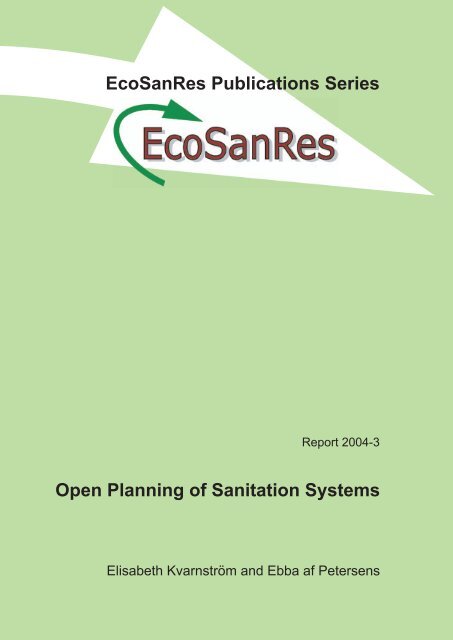
![Project Document [PDF: 2.31 MB] - EcoSanRes](https://img.yumpu.com/51279385/1/184x260/project-document-pdf-231-mb-ecosanres.jpg?quality=85)


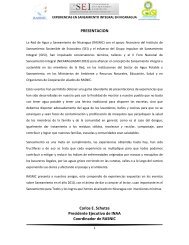
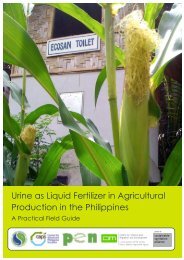

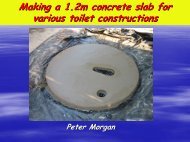



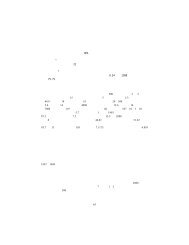
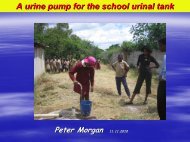

![Latrines à compost [high-resolution colour PDF: 12.3MB] - EcoSanRes](https://img.yumpu.com/31726141/1/185x260/latrines-a-compost-high-resolution-colour-pdf-123mb-ecosanres.jpg?quality=85)